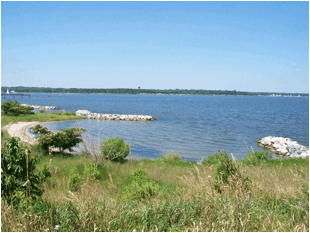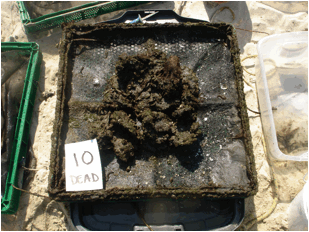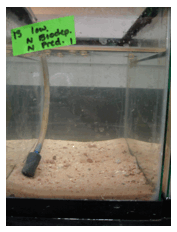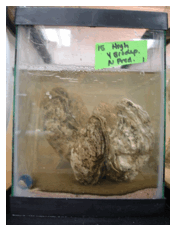Comparing the Effects of Biotic and Abiotic Components of Crassostrea virginica on the Epibenthic Community
Karen Kesler, 2008-Present
Crassostrea virginica is a benthic-pelagic coupler, feeding on phytoplankton from the water column and contributing to the benthos through biodeposition. Food that is not assimilated into the oyster is excreted as feces and pseudofeces, the two components of oyster biodeposits (Newell and Jordan 1983). Biodeposits transfer nitrogen, phosphorus, and carbon from the pelagic environment to the benthic environment, providing a basal nutrient source to the oyster reef food web (Ulanowicz and Tuttle 1992). My studies evaluate the impact those nutrients have on the oyster reef community assemblage and food chain. In addition they evaluate the effect of oyster reef structure on the community that recruits to the reef and how structure interacts with trophic transfer. Overall my dissertation investigates the role C. virginica biodeposits play in the reef community, with a specific quantification of the interaction of the structural and biotic aspects of oyster reefs.
With my dissertation I am investigating three aspects of the role of oysters within the oyster reef community: how biodeposits compare with reef structure as a determining factor of community assemblage, how trophic transfer is impacted by complex structure, and if biodeposits are being used as a basal resource by the oyster reef community. Together these studies will quantify the influence of the oyster biodeposits and the oyster structure on the reef community.
My first study tests if the shell structure of the oyster is the main driving factor in determining community assemblage on the oyster reef or if the biodeposits from the oysters provide an additional factor that affects community assemblage. Small oyster reefs were created from live oysters and oyster shells, the reefs were colonized for 1 year, and then community abundance, biomass, and diversity were compared between the two treatments.

Figure 1. Location of tray deployment for experiment 1.

Figure 2. Small sample oyster shell reef after one year of colonization.
My second study evaluates how the structure of the oyster reef impacts the trophic transfer of nutrients from biodeposits up through the food chain. Small mesocosms with combinations of complexity (high and low), biodeposits presence (present and absent), and predator presence (present and absent) were created to see how amphipod populations responded to these factors.


Figure 3. Low complexity treatment (right), containing a layer of sand as substrate and high complexity treatment (left), which contained a layer of sand and oyster clumps for substrate.
In my final study, I will evaluate what pathway nutrients from biodeposits take through the oyster reef system, specifically testing if biodeposits are being utilized as a food resource. Stable isotopes will be used to evaluate the trophic relationships of a field oyster reef. In addition, an isotope tracer will be used in a laboratory mesocosm in order to trace the path of biodeposit nutrients through the oyster reef food web.
For additional information on Karen’s project, contact paynteroysterlab@gmail.com